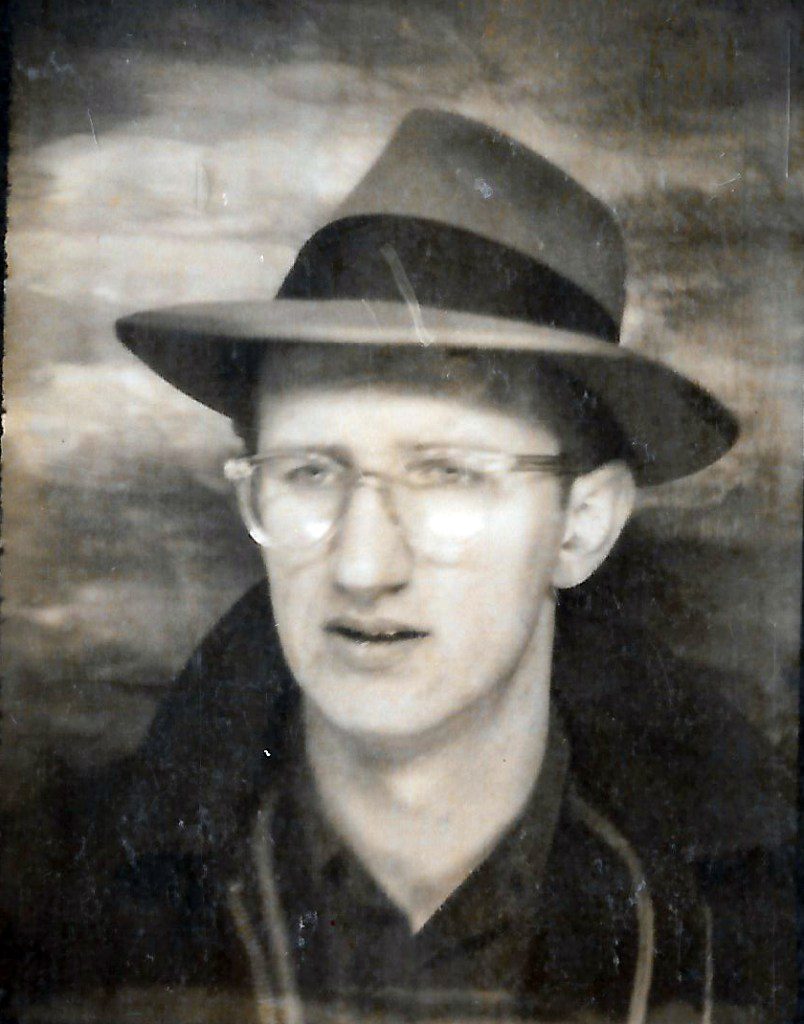The Secret Life of Steve Ditko: Spider-Man Co-Creator’s Family Opens Up
E
very year, when Uncle Steve went back home to Johnstown, Pennsylvania, from New York City, there was a strict rule: No one talks to him about work. He’s not here on business, his brother, Patrick, would tell the kids.
The adults, at least, knew about his profession as a comic-book creator, but to his nieces and nephews, he was simply the funny uncle who scientifically manufactured bobalki balls, the traditional Slovak Christmas dish. “We were told not to pester him, so we didn’t,” his niece Joanna Opela tells Rolling Stone, in an exclusive interview. “The things that he wanted to share with us he did.”
Still, in every Ditko house there was a wealth of comics, shipped back into the wilderness from Steve’s minuscule apartment in midtown Manhattan. The youngest of the nephews, Mark, was especially fond of Konga, a nazi-battling pseudo-King Kong. He had no clue his uncle drew the character.
One crispy Christmas during the early 1960s, Mark, only four or five, asked his uncle to sketch him a picture of a gorilla. Using only a pencil, his uncle cast a spell across the paper, and there he was: Konga, in all his glory.
“Uncle Steve,” Mark beamed. “You are really good.”
Steve Ditko lived a fragmented reality, with many worlds that only he could journey between. In the city, he never spoke about home, and at home, he never talked about life in the city. But at this exact moment, he momentarily revealed his secret identity. This was when Mark realized his uncle was magic.
Within years of Mark’s realization, Steve Ditko would forever change the cultural landscape by co-creating a superhero unlike any before him. One with insecurities, whose life mission was sparked by a massive mistake. He lacked social skills. His head buzzed with worry. Every issue ended with him steeped in depression. Contrasting other heroes who only covered half their faces with a cowl, Spider-Man hid everything.
Just more than 60 years later, you can’t walk into a preschool without seeing rows of cubbies lined with red and blue webbed backpacks. There have been cartoons. Video games. A ride at Universal Studios. Movies. Relaunches of movies. Relaunches of relaunches of movies. A multiverse with a spider-therapist, spider-baby, and spider-pig. Everything teeming with the themes set by Ditko and his co-creator, Stan Lee, in the first 38 issues and two annuals of The Amazing Spider-Man.
Yet Uncle Steve’s entire life, he, too, hid, living by rigid rules. From 1968 until his death in 2018 at age 90, he didn’t give an interview. He refused photos and commissions. It ascended to the point where he wouldn’t allow friends into his office for fear that they’d record him. “I never talk about myself,” he notoriously said in publicity for his 1968 DC co-creation The Creeper. “My work is me.”
Steve Ditko, circa 1950s
© 2018 Ditko Ink/Ditko Estate, All Rights Reserved.
Journalists called him the J.D. Salinger of comics and portrayed him as an Ayn Rand-obsessed recluse. Neil Gaiman referred to him as “impossibly uptight.” Peers refused to work with him. Fans harassed him, slamming their fists on his office door, trying to catch a glimpse. Pulling from the little he offered them, people dehumanized him, to the point it seemed unfathomable to think he had a life with friends and family. Critics jeered at his moral absolutism. Lee talked about him as if he were a stubborn quack who sabotaged his own career, and fans acted as if he were a traitor for leaving Spider-Man.
With a recent settlement over the rights of Ditko’s Marvel characters behind them, the extended Ditko family wants people to recognize that their uncle was a normal guy. But what is deemed normal is constantly fluctuating — and in this case, is defined in relation to the way Lee spoke of him to the press.
Today, Ditko would probably be looked at with more empathy, as a vulnerable character similar to Spider-Man. In exclusive interviews with Rolling Stone, family members and friends describe a driven artist who never fit into social norms, yet cultivated thriving relationships. Similar to how Peter Parker never lets loved ones get too close for fear it would put them in danger, Ditko compartmentalized his life, keeping work and family distinct to retain some power in a world that overwhelmed him. And the same way Spider-Man’s neuroticism makes him amazing, the traits that people marginalized Ditko for are what transformed comics forever.
IN MANY WAYS, DITKO WAS was always an outsider in the comic industry. He wasn’t from New York City and wasn’t Jewish. His peers didn’t necessarily choose comics; many of them tumbled into the industry due to antisemitic quotas in their chosen field of advertising. But to Ditko, creating comics was a dream come true.
Born in Johnstown on Nov. 2, 1927, Ditko came from a hardworking family of Slovakian and Ukrainian immigrants who helped build the mill town back up after an 1889 flood rushed through the city, decimating 1,600 homes and killing 2,209 people.
They were a family of Steves, his brother, Patrick, says. “It went down a line.” Ditko’s grandfather and dad were Steves. Patrick’s middle name is Steve, and Patrick named his son Steve, too, until five years ago, his nephew changed it to Stephen.
“I got calls from all around the world. People thinking I was my uncle,” his nephew says, explaining what prompted the name change.
Ditko was the oldest of four — two boys and two girls — in what his niece, Opela, calls “a big old Catholic family,” led by his carpenter dad and seamstress-homemaker mom. “When your dad tells you go do something, do something,” Opela says. They had a barn and garden, and there were chickens to feed. Steve chopped wood for the stove and shoveled coal for the furnace. In the Ditko household, everyone had to work.
“They were very Old World,” Mark says. “It was nose to the grindstone. Work hard.”
Comics were everything and everywhere in the house, and Ditko’s dad spent vacations posted next to the fireplace reading Prince Valiant strips.
Detective Comics Number 27 hit stands when Ditko was 12, introducing the world to Batman, a hero more terrifying than the criminals he faced. In his first appearance, he knocked a criminal into a vat of acid. “A fitting ending for his crime,” Batman says before swooping into the darkness.
Ditko looked up to the caped crusader, but he had much more in common with his most popular co-creation, Spider-Man, especially his alter ego, Peter Parker. They had the same lanky build. Same comb-over. Same thick glasses. Same bumbling social skills. Ditko’s senior-yearbook photo could have been Parker’s. With their collared shirts and slacks, it looked as if they shopped at the same clothing store — and while Parker quickly received a makeover after Ditko left in 1966, with future artists adding a sexy edge, Ditko continued shopping at that store for the remainder of his life, eventually adding fedoras and paperboy caps into the mix.
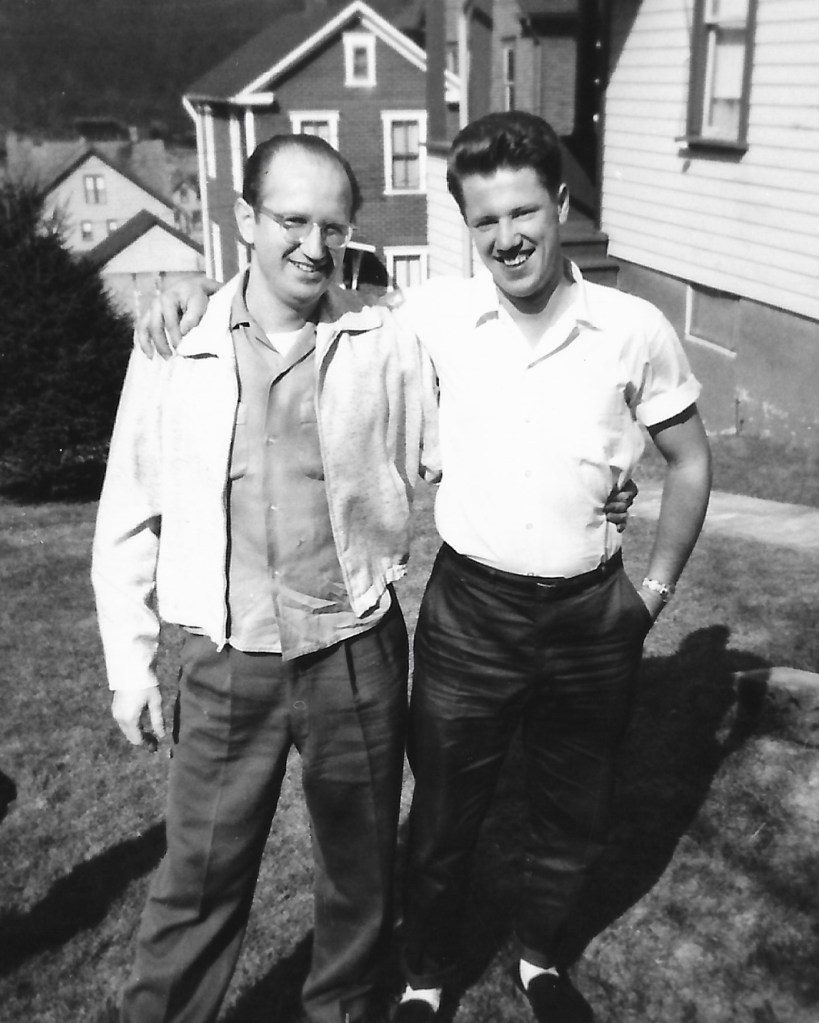
Steve Ditko (left) with his brother, Pat Ditko
© 2018 Ditko Ink/Ditko Estate, All Rights Reserved.
Like Parker, Ditko was “mild mannered,” says his brother, Patrick, seven years his junior. “Quiet and to himself” — the type to choose science experiments and books over hanging out with buds. Ditko built himself a locked hideout in the upper decks of the family barn, resembling the lab in which Parker created his webs, where he spent his free time tinkering with flasks, a Bunsen burner, and microscopes.
After high school, in 1945, Ditko enlisted in the Army, traveling to Germany via boat, publishing his first comics — single-panel gag cartoons — in the base newspaper. He sent letters home, doodling across the envelopes, asking how the family was, but mentioning zilch about himself.
After being honorably discharged in 1948, Ditko spent a brief period living at home in Johnstown, then made his way to Manhattan. His family knows little about his time studying at the Cartoonists and Illustrators School, which he attended from 1951 to 1953 under the tutelage of Batman artist Jerry Robinson, or the years he spent breaking into the industry, working for comic companies that paid little but offered creative freedom.
Most of Ditko’s characters, other than Spider-Man, lack romantic or sexual relationships, and even Peter Parker’s romantic storylines seemed to parrot Archie comic books. Ditko himself is not known to have had any intimate relationships in his life. “He could have been dating girls in New York, we don’t know,” Ditko’s nephew, also named Patrick, says. “But he would never talk about them.”
By the time he returned home in the mid 1950s to recover from a bout with tuberculosis, he had a fully formed secret identity.
“When he came home from New York and stayed with us while he was recuperating, I never knew that he had anything,” his brother says. “We slept in the same bed in our bedroom, and I never, never, never knew that he had tuberculosis until years after that.”
After a full recovery, Ditko returned to the city in late 1955, where he found his first work at Marvel Comics, then called Atlas, working under editor-in-chief Stan Lee for a four-pager in the horror-fantasy anthology series Journey into Mystery. By 1958, Ditko was one of Lee’s go-to artists, and soon, the guy he’d turn to when Jack Kirby, the gold standard in Lee’s eyes, fell through.
Spider-Man came from a hint of an idea Lee had in the early Sixties: An orphaned teenager becomes a hero named Spider-Man. That was the extent of it.
Lee pitched the concept to his boss-cousin, Marvel owner Martin Goodman. According to a 2015 BBC Radio 4 interview with him, Goodman replied, “Stan, that is the worst idea I have ever heard.” Kids were sidekicks, not stars. Spiders were gross. But Goodman begrudgingly gave Lee the go-ahead to do an 11-pager in Amazing Fantasy, knowing he was canceling the title, anyhow.
Lee passed the idea on to Kirby, his most frequent collaborator and the co-creator of Fantastic Four, X-Men, and Black Panther, who came back with a five-page tale of a teen with a magic ring that turned him into a brawny, generic adult superhero equipped with a web-shooting gun, which Lee then gave to Ditko to ink.
Here’s where things get murky. According to Strange and Stranger: The World of Steve Ditko, by Blake Bell, Ditko pointed out to Lee that Kirby’s version was eerily similar to the Archie Comics’ character the Fly, and Lee had him take over as penciler. In his 2002 autobiography, Excelsior!: The Amazing Life of Stan Lee, co-written with George Mair, Lee claimed he took Kirby off the title because his Spider-Man was too much of “a powerful-looking, handsome, self-confident typical hero type,” but in a 1990 Comics Journal interview, Kirby claimed he simply didn’t have time to continue with the character.
No matter what happened, Ditko took the reins, making Spider-Man the awkward nebbish he is today. Unlike Kirby and the many artists parroting Kirby at the time, Ditko’s art was weird, his characters gangly and unattractive. Ditko perfectly tapped into teenage awkwardness, and his art read like a silent movie, zeroing in on small emotional beats in a style that would later be deemed Decompression. His characters were trapped in a nine-panel grid making any divergence of structure that much more impactful. Everything was thought out: from his thin soles (so the stickiness seeps through) to his full mask (to hide his age).
Loneliness is laced throughout Spider-Man’s first appearance. On the opening page, a gang of giddy, Happy Days-looking teens point and cackle at a distraught Parker in the distance, who casts a Spider-Man-shaped shadow on the wall behind him.
“While it’s trying to convey a sense of strength, [the shadow] is blending into the wall,” explains Dave Gussak, a professor in the graduate art-therapy program at Florida State University and the author of The Frenzied Dance of Art and Violence.
Goodman canceled the title — then the sales figures came in. According to PBS, 250,000 copies were printed, and readers snapped them up. Seven months later, Marvel launched its newest hit: The Amazing Spider-Man.
As Spider-Man comics flooded newsstands, Ditko found himself more alone than ever. The comic industry that Ditko had entered into in the Fifties was changing. Marvel’s surge in popularity was covered by The Wall Street Journal and The Village Voice. Pop artists appropriated comic iconography. Marvel launched a fan club, the Merry Marvel Marching Society, and Lee spoke at colleges as the face of the company. No longer were artists required to simply create great work, they were expected to connect with fans.
Ditko’s second major Marvel creation, Dr. Strange, helped comics gain traction on campuses. Strange is a sorcerer who can project his spirit across dimensions and into dreams. Strange’s art is cluttered with claustrophobic shapes and swirls, pulsing with the same anxiety as Spider-Man, but reflected with expressionistic flair.
“A lot of the hippies in college were like, ‘Man, he must be doing a lot of the acid,’” says Mort Todd, a former Marvel and Cracked editor who was friends with Ditko for more than three decades. “Couldn’t be farther from the truth.”
Even alcohol was off limits to Ditko. “Never touched it,” his nephew Patrick says, although Ditko’s brother, Patrick, remembers him breaking this rule only once, to cheers at the elder Patrick’s wedding.
Even though it went against his core nature, Ditko appeared at the first New York Comicon, held in 1964 with around 100 attendees. Comic conventions offered creators a way to promote their comics, network, and supplement their income. “You talk to any creator that’s burst onto the scene in the last decade, chances are their work was discovered by an editor at a convention,” says Chris D’Lando, New York Comic Con’s event manager.
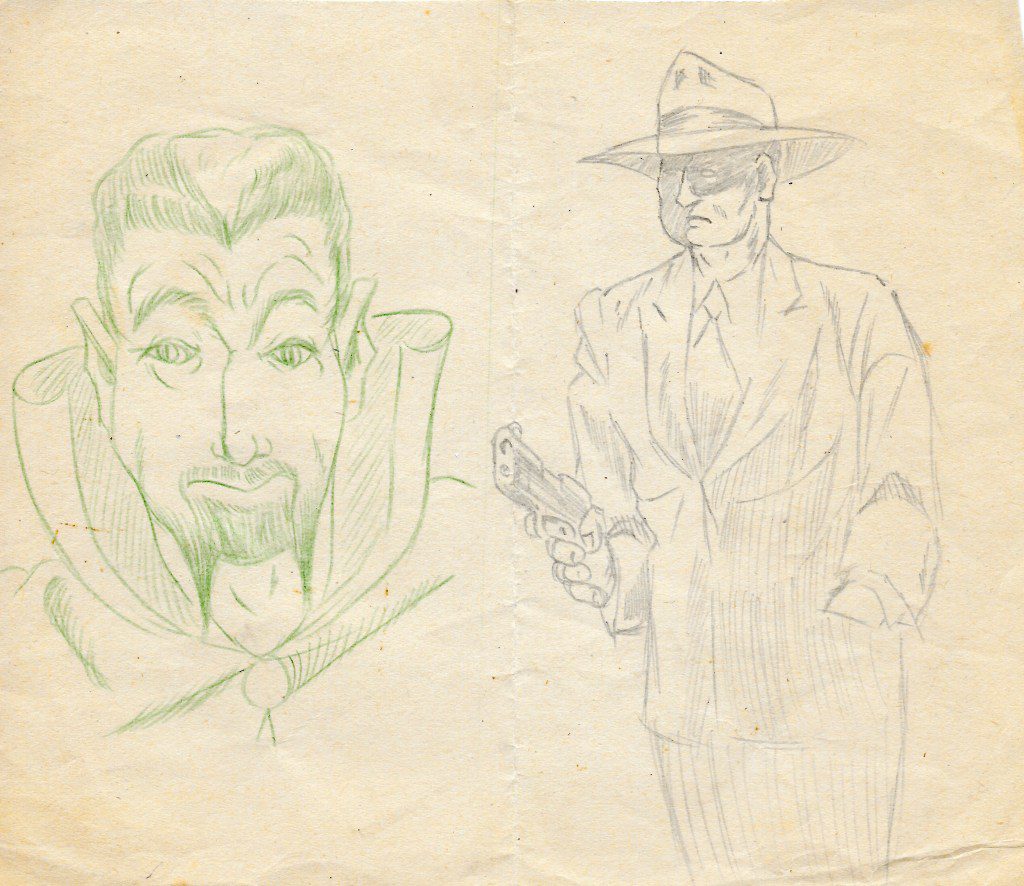
Early sketches of Doctor Strange
© 2018 Ditko Ink/Ditko Estate, All Rights Reserved.
But for Ditko, who avoided crowds, conventions added pressure that he never signed up for. “[Creators] like to stay home with our thoughts,” says Brian Michael Bendis, the co-creator of Miles Morales and decade-plus writer of Ultimate Spider-Man, who popularized the Decompression movement in comics. But “the reward [for success in comics] is that you don’t get to sit in your basement alone, you have to sit on a stage and stare at people, which is absolutely what most of us are not wired for.”
At the convention, according to Marvel Comics: The Untold Story, Ditko participated in what one fan said was “the most depressing exchange I ever had with a comics pro.” The fan asked Ditko how to break into comics, and Ditko told him the job “paid too little and had few lasting rewards.”
Ditko hated his con experience, too, as he explained in a 2015 essay: “I was continually asked questions about things of which I could never have any kind of knowledge, information: policies of comic companies, people I never met.”
He never made an official convention appearance again.
During Ditko’s time at Marvel, he was work-for-hire, meaning assignments were month to month. No guaranteed contracts. No health insurance. Marvel retained copyright of all characters.
Unlike other comic companies, where pencilers received full scripts to draw from, Lee used what is called the Marvel Method: Lee came up with a germ of an idea for an issue, maybe a paragraph long, handed it off to the penciller, who drew the issue, pacing the story, filling in the details and plot points. Then Lee added dialogue and narration.
“Comic books never had a strict division of labor,” Ditko wrote in a 2015 letter to David Currie, the author of Ditko Shrugged: The Uncompromising Life of the Artist Behind Spider-Man. “At the time, who created what was of no importance.”
This method only became an issue after Lee turned Ditko onto the philosopher Ayn Rand, feeling as if Ditko would be interested in her definition of a hero.
Rand laid out her theories, called Objectivism, in her novels. Everyone makes their own choices and morality is black and white — there is no gray. This unbending worldview fit easily within Ditko’s rigid thinking. Rand was staunchly anti-collectivist, in essence because of her negative upbringing in the USSR. At a time when Ditko felt more and more outcast, Objectivism glorified the independent thinker who doesn’t fit within social conventions. People-pleasing “looters” and “moochers” try to take advantage of the Randian hero, who fights back by withholding their talents, no matter how much it costs them. Recognizing that he wasn’t being recognized for his creative contributions, Ditko pushed to be credited appropriately.
Lee replied to Ditko’s request by mocking him publicly. After Ditko took on more control of plotting with issue 18 of The Amazing Spider-Man, Lee promoted the issue in other titles’ letter pages by writing, “A lot of readers are sure to hate it, so if you want to know what all the criticism is about, be sure to buy a copy!” Two issues later, on the first page of The Amazing Spider-Man, Lee derided Ditko, writing, “Many readers have asked why Stan’s name is always first on the credits! And so, big-hearted Lee agreed to put Stevey’s name first this time! How about that?!!” As promised, in the credits, Ditko’s name is listed first, but Lee’s is twice as large.
In issue 25, the issue when Lee acquiesced to list Ditko as plotter, Lee credited him as “Scowling Steve.”
Their relationship had been fraught since Spider-Man’s first appearance. Lee’s scripts clashed with Ditko’s art, most evident in Spidey’s comedy routines while battling villains. Lee wanted a hero or villain on every page, and Ditko leaned into Parker’s personal life.
Lee, one of his generation’s greatest self-promoters, easily fell into the Randian “looter” and “moocher” tropes. “Stan had a tendency to believe complainers, OOs [Ditko’s term for outsiders], know best,” Ditko wrote in a 2003 essay. “He granted them some kind of superior insights, knowledge. So they should be given arbitrary authority over the ideas of the editor, writer and artist.”
While Lee portrayed himself as the reader’s hip, liberal uncle, Ditko’s conservative politics played out on the page. Police were depicted exceedingly positively. In Amazing Spider-Man Number 36, Ditko introduced a villain named “the Looter.” Two issues later, Parker walked past a group of campus protests and scoffed, “Another student protest? What are they after this time?”
With journalists happy to give Lee credit for the entire Marvel universe, Lee wouldn’t speak up about Ditko’s contributions, and even Ditko’s family couldn’t avoid reading the press.
“They were outraged,” Stephen Ditko remembers. It reached the point where during one of Ditko’s Johnstown visits, his siblings confronted him. His nieces and nephews, playing in a room nearby, heard the outbursts. Brothers and sisters forcing Ditko to cross worlds. Telling him he needed to stand up for himself. Giving him advice. Ditko sat there silently. “Visibly upset, and very out of character for him,” Stephen recalls. The men huddled around him, speaking in low tones, asking him what he planned to do. Ditko finally spoke up, and though Stephen couldn’t hear it, he came up with a plan.
Around the time issue 25 dropped, Lee stopped communicating with Ditko completely, according to a 2001 Ditko essay. Ditko would drop off pages to production manager Sol Brodsky, “while Stan, utilizing some kind of radar sense that would’ve made Daredevil envious, as usual managed to remain in his office until the artist had left, so that in all my life I never saw the two of them together,” Roy Thomas, Lee’s successor as editor-in-chief of Marvel Comics, recalled in Alter Ego Number 160.
In November 1965, Ditko handed in his final pages, not returning to Marvel until 1979.
In his autobiography, Excelsior, Lee claimed to not understand why: “Little by little I noticed that Steve was beginning to give off hostile vibes. Steve wasn’t the most communicative guy in the world, and to this day I’m not quite sure what the problem was.”
Tired of fans asking why he quit, Ditko wrote a 2015 essay, saying, “Why should I continue to do all these monthly issues, original story ideas, material, for a man who is too scared, too angry over something, to even see, talk to me?”
The years following his Marvel exit saw Ditko working across the comic landscape, co-creating Hawk and Dove for DC, and reimagining the character Blue Beetle into a teenaged hero for Charton comics. After Spider-Man, he had rules. Before he entered a project with a writer, he’d call them and ask, “How do you define a hero?” to ensure their definition didn’t fall into the gray. He began getting a reputation with editors as being difficult.
“Steve is the kind who would starve rather than violate his principles,” the former Marvel editor-in-chief Jim Shooter said in a 2011 blog. During a stint on Iron Man, Ditko refused to draw a picture of the hero drunk. He turned down a Batman script because it was supernatural. He rejected high-paying assignments because something went against his values.
“He would never argue with anybody,” says Jack C. Harris, a former comic editor, author of Working with Ditko, and friend for 40-plus years, whose office at DC was a safe space for Ditko. “If he really objected to something … he would just say, ‘OK, thank you. I had fun. Bye, and I’m gonna work on something else now.’”
Though many refused to work with Ditko, others put complete trust in him, allowing him to make whatever changes to a script he wanted, such as when he returned pages of Squirrel Girl with a different costume than what was described in the script. Squirrel Girl co-creator Will Murray envisioned a crisp Peter Pan-like costume, and Ditko came back with one made up of salvaged garments, similar to what a squirrel would create. “He was probably the smartest artist in comics,” Murray says. “He always thought problems through.”
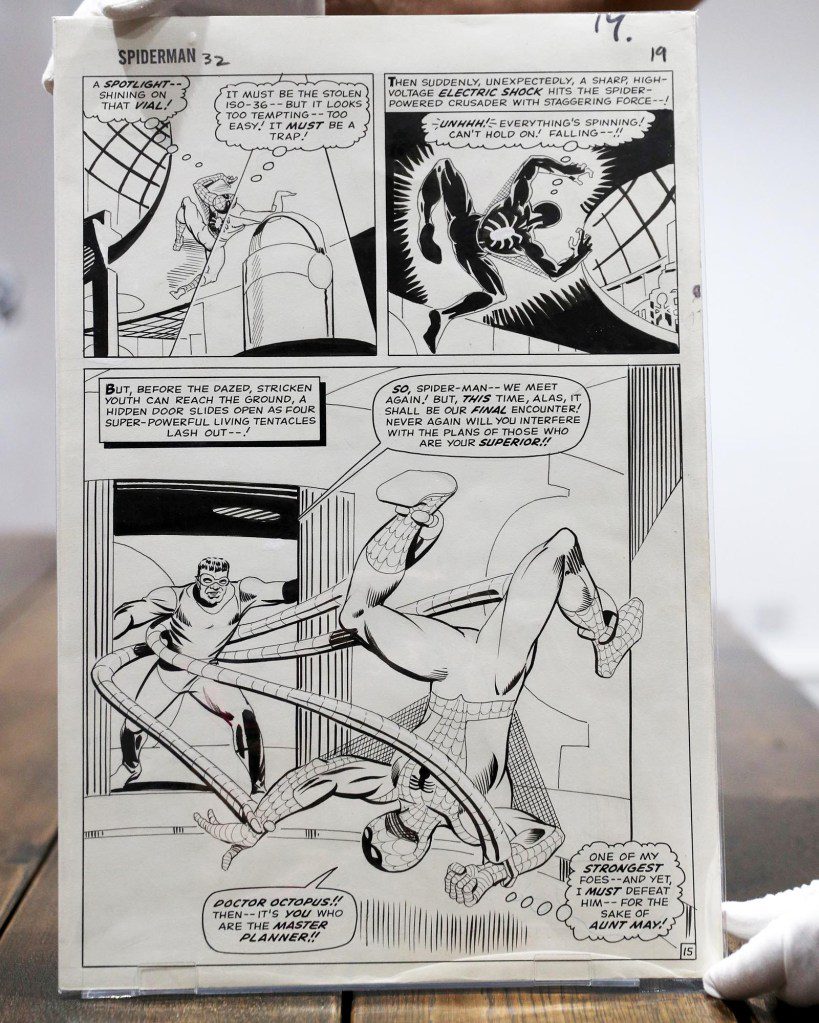
A Steve Ditko hand drawn page from The Amazing Spiderman (1966).
Andrew Matthews/PA Images/Getty Images
During the late Sixties, with steady work coming in from DC and Charlton, Ditko had leverage to take risks, becoming one of the first popular creators to dive into creator-owned work. He joined a team of creators organized by friend Wally Wood to publish witzend, an underground magazine that included comics by The Spirit’s Will Eisner and Pulitzer Prize winner Art Spiegelman. According to Ditko Shrugged: The Uncompromising Life of the Artist Behind Spider-Man, the magazine bombed financially, but offered incredible creator freedom. During a time when a Comics Code enforced over-the-top rules such as not allowing the term “weird” in titles or the portrayal of werewolves, witzend had no editorial intervention.
According to the introduction to a 2014 collected edition of witzend, written by Bill Pearson, Wood and Ditko were polar opposites politically, engaging in “fierce” debates, but they were close friends who were passionate about creator rights.
“Wally Wood did an outstanding thing for writers and artists,” Ditko wrote in a 2014 letter to Currie, “an opportunity to create and copyright what one creates, protecting and able to cash in on it at any future time.”
In the third issue, Ditko introduced his most controversial character — one he would come back to persistently for the remainder of his life — and, unlike with Spider-Man, he retained full rights. By then, comic heroes had begun blurring their morality, inching their way to becoming corrupt Watchmen, and Ditko felt readers couldn’t decipher right from wrong. His creation, Mr. A, told a morality play steeped in exaggerated violence. Like Ditko, Mr. A compartmentalized his life: Hiding behind an emotionless metal mask, he never reveals his origin story. In his first appearance, Mr. A, spouting Randian philosophy, punches a murderer and leaves him dangling off a rooftop until the guy falls to his death.
“I don’t abuse my emotions,” Mr. A says, echoing the merciless tone of early Batman stories. “I have no passion for aggressors, only for their victims, for the innocent.”
Letters poured into comic companies, complaining about the brutality. Dan Thomson, a longtime editor of the Comics Journal, called Ditko’s new work “propaganda — and badly done propaganda at that — for a frightening philosophy.”
Ditko pulled further from the public view.
AWARD-WINNING INDEPENDENT-comic creator Dean Haspiel remembers very little about the time he first knocked on Ditko’s door in 2005. “Oh, my God,” he thought to himself, taking a deep breath. “Legend was he would just slam the door on you if he didn’t recognize you. Not in a cruel way, but just like, ‘I don’t have time for this,’” he says.
Anyone could visit Ditko’s office at 200 W. 51st St., only blocks from Times Square, where costumed Spider-Men clicked photos with tourists. Ditko’s name was on the door, and his phone number was in the phone book. Located on the seventh floor of an old 12-story building, his office was lined with bookshelves brimming with philosophy books, and had a single chair, so visitors knew they weren’t welcome. But to even know that much, you’d have to be one of his handful of trusted confidants, people he believed wouldn’t take pictures or record conversations.
Haspiel felt it was acceptable to visit since it was a business office. Ditko cracked open the door, wearing a button-down and looking disheveled, as if he had to pull himself away from his work.
It was the first of five visits over the next few years. Each time, Ditko would barely crack the door, and step out into the hallway where they’d chat. Visits would last five to 20 minutes. One time, Haspiel even brought his mom. “I can’t really remember the conversations because you’re in a fugue state. You black out when you are around someone who is that accessible yet inaccessible at the same time,” Haspiel says. “I would show him some artwork. He never showed me anything. I always felt like I interrupted him because I’m sure he was 24/7 in his own brain and space.”
Being a friend to Ditko wasn’t easy, says Squirrel Girl co-creator Murray, whose decade-long relationship ended in the late 1990s, when Murray shifted careers to become a psychic and medium and felt Ditko wouldn’t approve.
“Socially, he could be difficult,” Murray says. “He had so many rigid walls around him about certain things that people didn’t understand. There was always this risk of people saying or doing the wrong thing and being completely thunderstruck that this friendly guy suddenly just blew up in their face over something innocuous.”
During one phone call, Ditko told Murray that people should never contradict themselves. “I said people basically are self-contradictory,” Murray recalls, so Ditko hung up on him, and they didn’t speak for years.
The relationship never felt stable, Murray says: “In the back of my mind, I often wondered, ‘Did Steve think that maybe someday I would take everything that he told me and write an article about it and thus betray him?’”
But there were friends who Ditko allowed greater access to his many worlds. They may not have known about his time in the Army or his family, but he had friends who he’d meet weekly for burgers to discuss movies and New York history, friends he allowed into his office to set up his VCR. “He already had a copy of the movie Fountainhead ready to watch,” Todd said. He even let Todd slip in a Spider-Man question or two over the decades.
“I didn’t just come straight out and go, ‘Why do you hate Stan so much?’” says Todd. “We’d just be talking about something and it would segue into other things.”
Ditko’s preferred communication was handwritten letters, and he cultivated a web of pen pals. He replied to everyone who wrote to him, even going so far as to write explanations of why he refused to sign autographs, before signing the letter.
“He once told me that the difference between myself and some others is I was concerned and willing to talk about his latest creations or characters rather than just dwell solely on Spider-Man,” says Joe Frank, who blindly contacted Ditko in 1981.
Ditko and Frank wrote each other nearly 1,500 letters, ranging from four to 10 pages, discussing Ditko’s appreciation of Don Rickles and his respect for Dan Rather and William Shatner, two examples, Ditko felt, of people who didn’t allow one role to define them. Frank mentioned to Ditko that he loved the first season of Lost in Space. Although Ditko wasn’t a fan, he sent him newspaper clips when one of the actors died. “Not only did he remember, but he thought enough of me to do that,” Frank says.
When Ditko stopped responding in 2018, Frank wrote weekly for five weeks, then penned one final letter saying, “Thank you very much for all that you’ve given me.”
Ditko continued visiting home every Christmas and Fourth of July, but by the turn of the century, the visits had slowed to a trickle. He was aging, travel was hard. Most family members also remember his later years based on the letters he sent.
When he did trek home, he requested the events were only for family — friends not allowed. By the time they were adults, his nieces and nephews had figured out just what their uncle did, especially since he had always sent boxes of his creator-owned work home. They also learned about the mystique surrounding him.
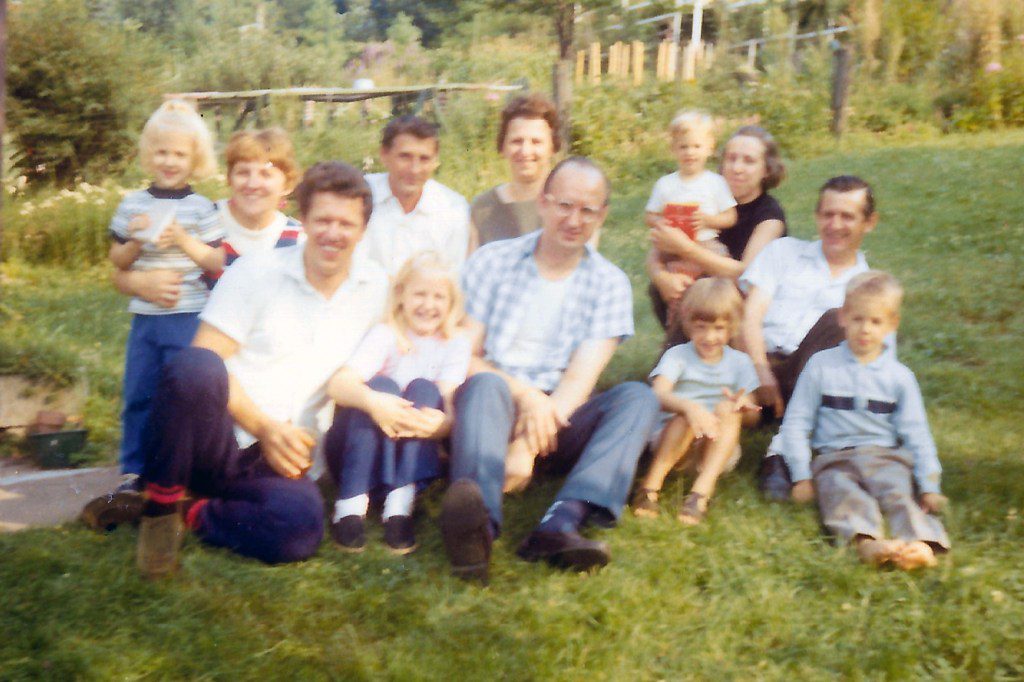
Steve Ditko with family
© 2018 Ditko Ink/Ditko Estate, All Rights Reserved.
Ditko’s nephew Patrick was in grade school in the late Seventies when his peers called him delusional because he told them his uncle created Spidey, so he stopped telling people. “There was no point,” he says.
As an adult, Mark Ditko became a fan of comics himself, and in the 1990s, he frequented conventions and met creators his uncle had worked with, many who gushed with praise. He would write his uncle 20- to 40-page letters, discussing politics. But at cons, he began hearing the myths of the recluse, the bitter old man. “I did not do something because I knew he wouldn’t want me to,” he says.
Two years after the Dr. Strange movie hit theaters, Mark visited the 2018 New York Comic Con, surrounded by fans who might not know the role his uncle played in creating the characters who were plastered on their shirts, socks, and backpacks. Mark stopped at a dealers’ booth to flip through original artwork.
Until the mid 1970s, Marvel held onto creators’ original artwork. “Few cared about it,” Shooter wrote in a 2011 blog post. “As the collector market grew stronger, and the artwork became valuable, artists started caring.”
Ditko himself never put much value on his original artwork. To him, he was paid for his work and he was on to his next project. There are even stories of him using invaluable original artwork as cutting boards. But Ditko did not like the idea of others having his artwork, either. In a 1993 essay, he referred to the art market as a “thieves market,” because, Ditko said, most of his Spider-Man artwork had been stolen from Marvel offices by employees.
During the early 1980s, according to Marvel Comics: The Untold Story, Marvel returned original art to many artists in exchange for them signing agreements acknowledging they created it work-for-hire. “The release form is almost a full page of binding conditions.… All rights are with Marvel,” Ditko wrote in his 1993 essay, acknowledging that he received much of the Dr. Strange work back, as well as two full issues of Spider-Man and a third almost-complete issue.
In 2017, a single page from Spider-Man Number 25 sold for $105,000. In 2008, the pages from Spider-Man’s first appearance were anonymously donated to the Library of Congress. Ditko told a reporter from the Chicago Tribune, “I couldn’t care less.”
Today, the Ditko family owns no original pages.
At the convention, Mark heaved open a binder of original pages and was thrown back: full stories created by his uncle in the 1960s, selling for $20,000 to $30,000 per page.
“I had to leave,” Mark said. “It was all stolen.”
FOR THE FIRST TIME SINCE 1965, Ditko and Lee spoke in person again, in a meeting held at Marvel’s 387 Park Avenue South office in the summer of 1992.
Ditko had been freelancing with Marvel for years, and Lee was cooking up an idea for a garbageman superhero from the future. Marvel’s then editor-in-chief, Tom DeFalco, thought, Maybe they could work together?
“Other than a slight pause after I [told] Steve, over the telephone, that Stan wanted to meet with him to discuss a new character, there was no hesitance for them to meet,” says editor Jim Salicrup. “I like to joke that I imagined Steve thinking during that very brief pause, ‘Ah, Stan’s finally come crawling back!’”
The 1990s had been tough for Ditko. He would shuffle through the trendy Marvel offices lugging his portfolio, looking like a character from Death of a Salesman. The notoriously frugal creator sometimes wore taped-together shoes. “A lot of the editors would make fun of Ditko,” seeing him as dated, says the former Marvel editor Todd.
There was a crew of “hot superstar artists” whose “signatures would get bigger and bigger on their art,” Todd says. On their backs, Marvel sales skyrocketed, with artist-tagged relaunches of Spider-Man and X-Men titles selling millions. Then in 1992, they all walked — they’d seen what the industry did to the early creators and swore it wouldn’t happen to them
But they were also inspired by Ditko’s creative-owned work, says Todd McFarlane, one of the artists who made the jump, going on to help found Image — the third-biggest comic company in the world, publishing only creator-owned work, including The Walking Dead, Saga, and McFarlane’s Spawn. “I basically say I’m a bizarre clone of him. Do Spider-Man. Make your reputation … then go and do some of your own crazy stuff.”
The 1992 meeting between Ditko and Lee lasted a half hour, according to DeFalco. “Stan jumped up and embraced Steve as soon as he entered the room,” he said in an interview with Currie, his biographer. “They seemed very happy to see each other.”
Eventually, Ditko passed on working with Lee on the garbageman-superhero, feeling that the future portrayed in it was too dismal; he wanted something positive.
“After Steve explained why he didn’t want to work on such a character, Stan went for broke and tried to talk Steve into doing a Spider-Man graphic novel with him, telling him it would sure to be a big hit,” Salicrup recalls. “Think of all the money we’ll make,” Salicrup remembers Lee saying, in a 2018 blog post, but Ditko declined, saying he could never care for the character like he once had.
Salicrup left Marvel soon after, but believes if he had stayed, Ditko and Lee would have worked together again, on something with a more positive future. “I could’ve easily talked Stan into working on such a character with Steve,” Salicrup says.
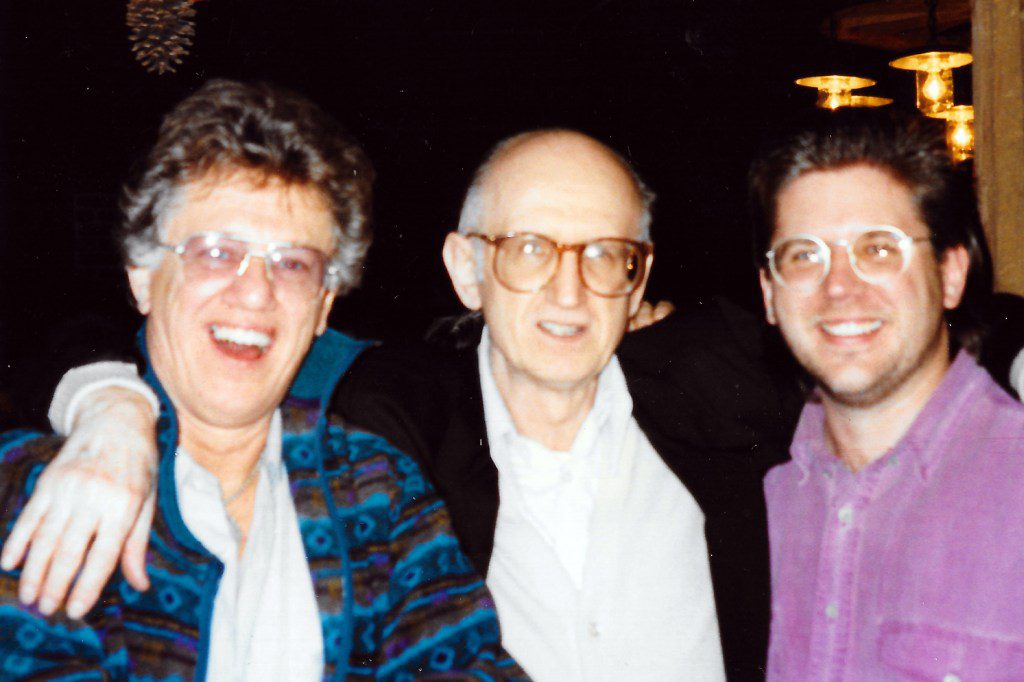
Patrick Ditko, Steve Ditko, and Mark Ditko (from left)
© 2018 Ditko Ink/Ditko Estate, All Rights Reserved.
As close as the reunion was, credit continued to cause strife. In a 1998 issue of Time, Lee was credited as Spider-Man’s creator. In a 1998 issue of Comic Book Marketplace, Lee claimed he came up with the idea for one of Ditko’s most iconic scenes. Ditko wrote letters to the magazines complaining. Lee responded with an open letter claiming he “always considered Steve Ditko to be Spider-Man’s co-creator,” but Ditko took offense to the word “considered.”
“At that point I gave up,” Lee said in the 2007 BBC documentary In Search of Steve Ditko.
Although Ditko disappeared from mainstream comics in the late 1990s, every day he shuffled 500 feet from his tiny rent-controlled apartment to his minuscule office on the same street to work. Though the creator-owned work he focused on during his last decades didn’t have Spider-Man sales, they had plenty of Kickstarter backers. He was doing fine financially, receiving royalties from comics, though not movies or merchandise, according to his family. Todd also believes he was receiving Social Security. He even began writing essays to dispel the rumors about himself. He realized that by not “saying the truth,” his nephew Mark says, he’d emboldened the myths.
In 2017, Ditko made a furtive appearance at New York Comic Con after staff talked him into checking it out, hoping to court him as a special guest, but in a sea of cosplay spider-people, no one recognized Ditko.
Six and a half years later, there’s a play based on Ditko, and the family’s working on a biography. There’s a DitkoCon and murals throughout his hometown. One is in the cover to this years’ Johnstown visitor guide. “He would hate it,” says Matt Lamb, a Ditko fan who never met the artist, but who organized the mural and the convention in his honor. “We won’t let people like Van Gogh or Picasso fade away because they had such an impact on the art world. We’re not gonna let Steve fade, either.”
Ditko wasn’t wired or trained for the celebrification of comic creators, says McFarlane, who mentors young creators on marketing themselves. “There are hundreds and hundreds of artists that I think draw circles around me, and yet I am going to have a better career than them. Why? Because I hustle.”
People would view Ditko much differently in 2024, says Ultimate Spider-Man’s Bendis. “What could have been his journey with mental health, at a time when that would have been seen as a negative, we look at today as something to celebrate and to rally around.”
Fans, he says, are much more respectful of an artist’s wishes and understanding of artist rights. Many of the career moves that people snubbed Ditko for, such as going independent, are now the norm. “You brought us Spider-Man,” he says. “We love you.”
The Marvel and DC universes remain awash with his characters. The Creeper. Hawk and Dove. Speedball. Squirrel Girl. Spidey’s entire rogues’ gallery. From 1975 to 2005, nearly every comic produced by Marvel had the words “Stan Lee Presents” on the credits page, although Lee stopped writing regularly in 1972, but today, issues often begin with Ditko listed as co-creator of his characters. This August, at the annual D23 convention, Ditko will be inducted as a member of the 2024 Disney Legends Class.
Everyone who writes Spider-Man or Dr. Strange is “talking to Steve Ditko,” says Tom King, a DC Comics writer who implements Ditko’s nine-panel grid and wrote a “Steve Ditko-esque” character that appeared in the series Rorschach, about the Watchmen character modeled on Mr. A. “You’re adding to a world other people created, so you’re not creating your own stories. You’re having conversations with generations that came before you.”
By the early aughts, an aging Ditko stopped ferrying home to Johnstown, instead communicating with family through letters. His nieces and nephews love the Marvel movies. His niece especially adores Tom Holland in the role of Spider-Man. It’s impossible to not be a fan, Mark says. It was a “perfect storm back there at Marvel in the early 1960s, and it was Stan Lee, Jack Kirby, and Steve Ditko,” Mark says. “If probably one of them wasn’t there, we probably wouldn’t have as much as we have.”
The last time his brother Patrick spoke with Ditko via phone, Steve was in the hospital.
“Why aren’t you working today?” Patrick said, and Ditko paused, then asked how Patrick’s wife was doing. Soon after the call abruptly ended, Ditko discharged himself, retreating to his comfort zone, alone, in his apartment and office, his treehouse, Peter Parker’s laboratory, where he first invented his magnificent webs.
“He never should have went home,” his nephew Patrick says. “We were calling and we ended up doing a wellness check. The police broke in.”
His body was discovered in his apartment on July 29, 2018. It’s estimated that he had a heart attack days earlier. He was 90. One of the first things his brother said to his kids after learning of Ditko’s passing was that the family needed to write a book and title it “Steve Ditko, the Man.” (On June 13, 2024, Patrick Ditko passed away at 89. This was his final interview.)
Steve Ditko’s body was cremated due to decomposing. “That wasn’t his request,” his nephew says. “His ashes were spread, and that’s all we’ll say.” The family held a small mass, but they won’t reveal where. Only his brother attended.
“I didn’t want it to be made public because I was afraid of what might happen,” he says, concerned fans and locals would show up. “I called my relatives and I told them, ‘There’s going to be this [mass], but I don’t want you to attend.’ They got upset about it, so I said, ‘You know what, that’s the way it is.’”
Weeks later, the family trekked to Manhattan and entered Ditko’s office.
Once again, his nephew Mark was dazzled by his uncle’s magic. The door to Ditko’s office was jammed shut with hundreds of unread letters from friends and fans, delivered in the month since he’d been there. On the walls were nature scenes, visions of his childhood. His apartment had a file of clipped articles from over the decades. All about Spider-Man.


